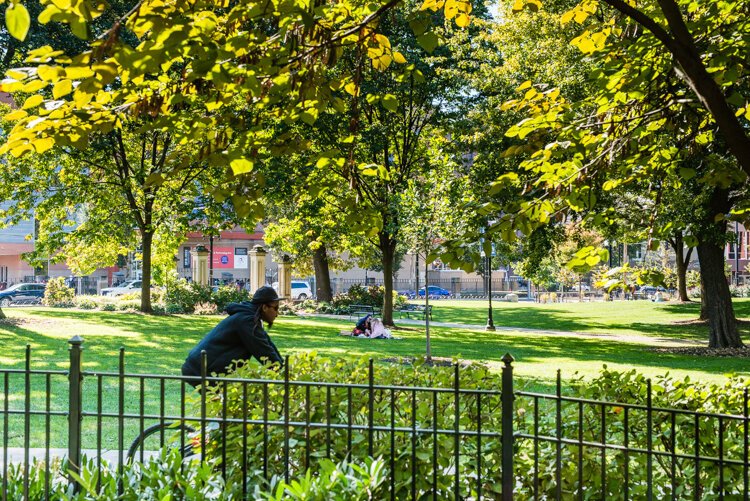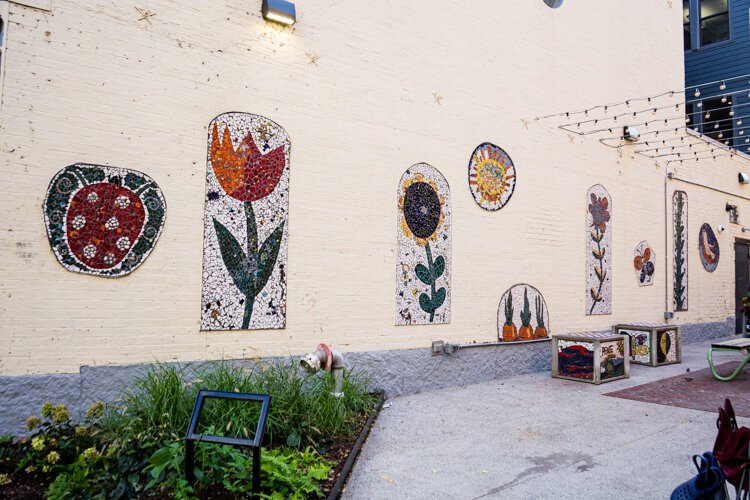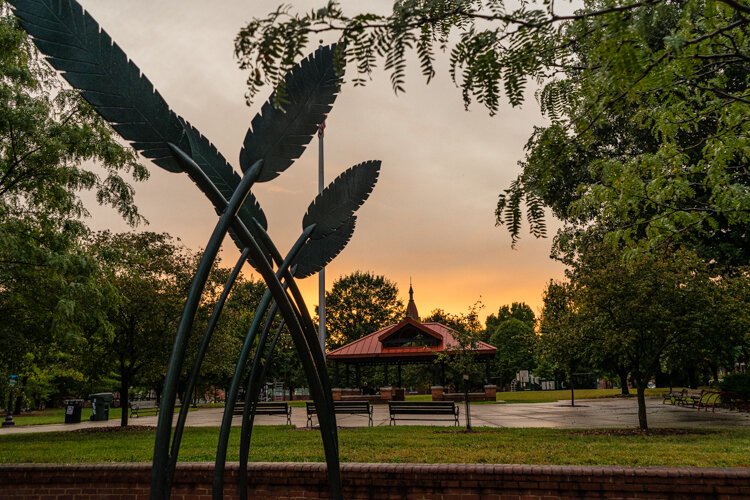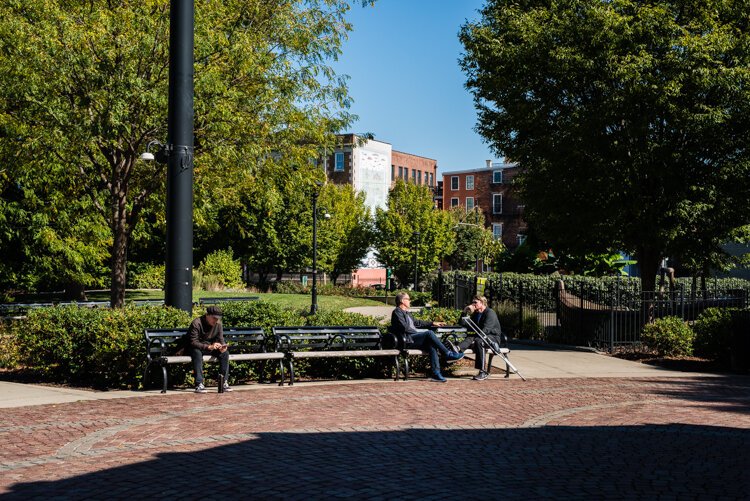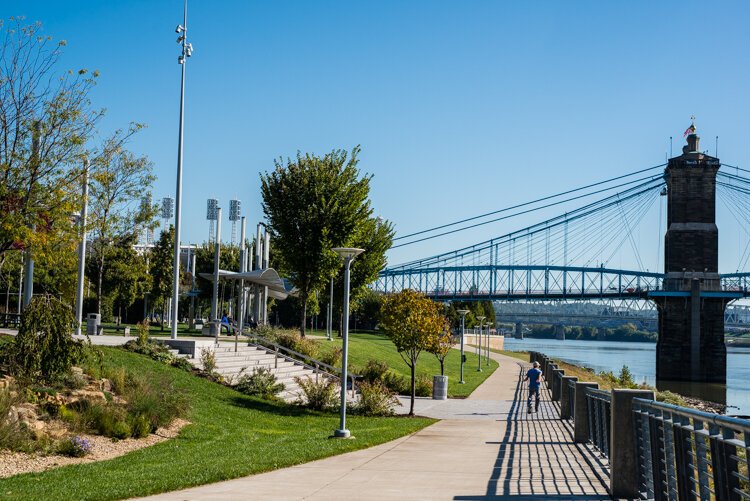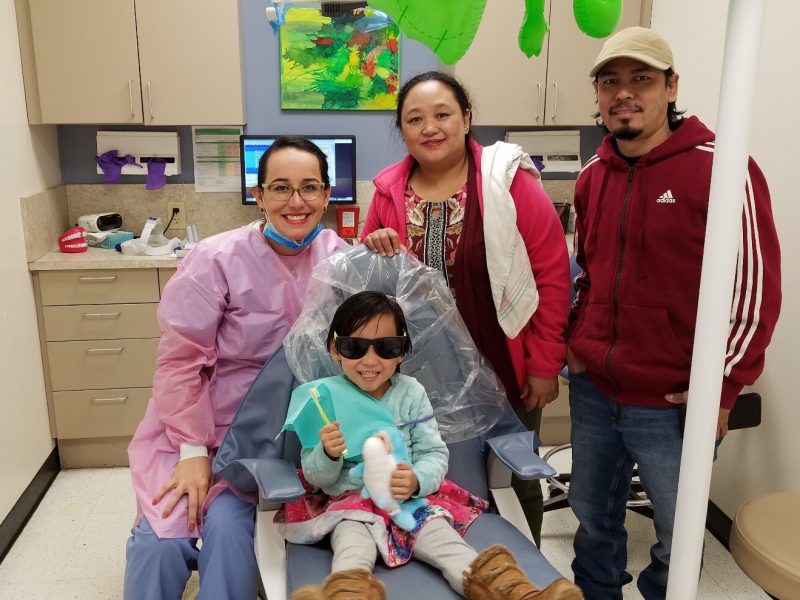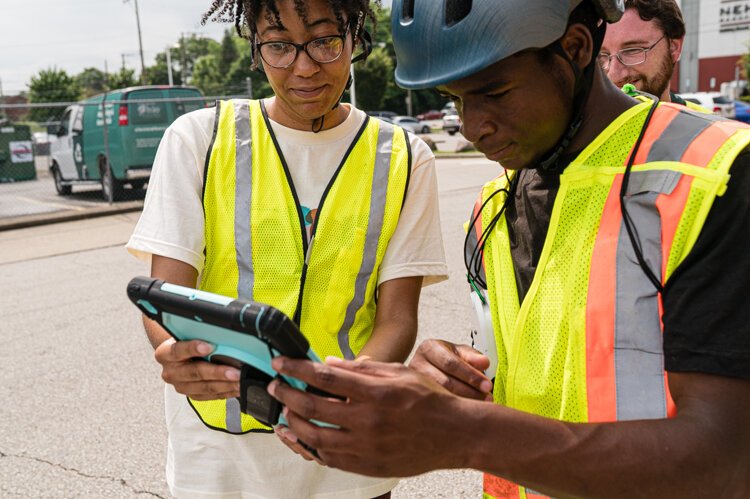The Public City: Why public spaces are essential to our physical, political, and social health
The quality of a city’s public places – its parks, streets, trails, commons and greens – are increasingly considered a barometer of the quality of life in an urban area.
Cities are engines of our local and national economies, and centers of creativity, culture, and entertainment. But they are under more pressure than ever. This is the second in a monthly series, The Case for Cities, that will look at how Cincinnati and similar cities can grow by becoming places of choice, as well as models of social justice.
Located in the heart of the Over-the-Rhine entertainment district, Imagination Alley beckons passersby to a vision: “Imagine Peace and Unity.”
The words on the entryway arch are written in a mosaic of tiles created more than 15 years ago by students and residents of Over-the-Rhine. The neighborhood, of course, has transformed since then. The 1300 block of Vine is the center of the OTR entertainment district, populated now by trendy restaurants, bars, shops, apartments, and offices.
Vine Street had a makeover in those years, and so did Imagination Alley. Today, it’s Cincinnati’s newest, and perhaps smallest pocket park, and its renovation was christened in September with a ribbon cutting complete with the mayor and other City Hall officials.
Renovations or not, Imagination Alley has always been part of home for James and Vicki Stanford. Married for 28 years, the couple have lived in a Vine Street walk-up next door for 26.
For the Stanfords, this oversized, rehabbed alleyway is a space for rest, leisure, catching up on the neighbors, bantering with passersby, and watching the passing parade that is Vine Street.
“This is our front yard,” Vicki says. “We don’t have no grass, no trees, no sunshine. We all live in apartments. Just a bunch of old retired people with nothing else to do.”
Exactly what a city’s public spaces are meant for.

The quality of a city’s public places – its parks, streets, trails, commons and greens – are increasingly considered a barometer of the quality of life in an urban area. Just as in cities as a whole, they are places owned and enjoyed by people of all incomes, races, and backgrounds. Investment in their creation and maintenance says a lot about a city, says Vikas Mehta, a professor of urbanism and expert on public spaces at the University of Cincinnati School of Planning.
“If you carefully observe the public spaces, you can actually read a city,” he says. “The sense of place can be understood through public space.”
“They’re places where the joys and sufferings of urban life, all the opulence and the squalor of it, are displayed,” Mehta says.
Neighborhood public places, even those as tiny as Imagination Alley, are also places where residents become citizens, Mehta says. Creating these places, protecting them, maintaining them, using them, and preserving them can transform one from a mere resident to an engaged civic activist.
“That’s where public space, even in this small form, becomes symbolic,” he says.
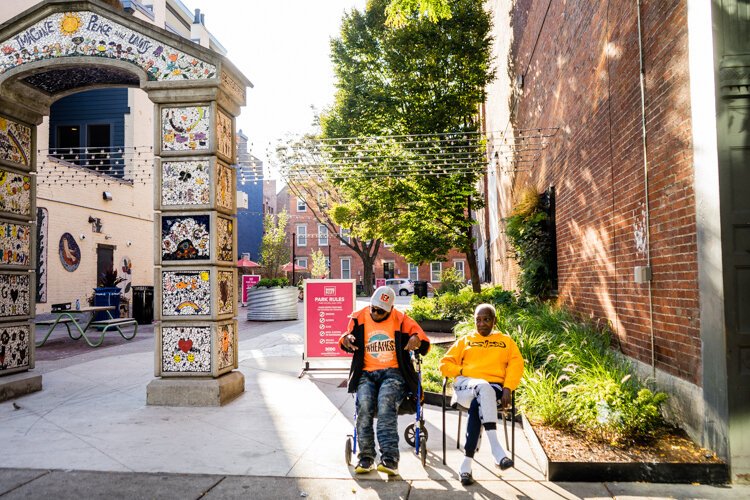
Indeed, Vicki Stanford has shown up at Over-the-Rhine Community Council meetings to voice her concerns about the pocket park, most recently to complain about the large signs the developer, 3CDC, has placed in the space. Three 2-by-4 foot signs in the confined space of one block: “No Grilling No Bikes No Glass No Alcohol No Smoking,” they demand.
That’s not exactly rolling out the welcome mat.
But the rest of Imagination Alley is like a shiny jewel in the urban landscape. A concrete arch is inlaid with colorful tiles proclaiming “Peace, “Love,” “You Are the One” and other uplifting messages. On one wall, a tree made of tiles, with the leaves memorializing the names of those who made them. Vicki Stanford proudly shows her name to visitors. Laid into the walk are more mosaic-tile flowers.
Back in 2005, before Over-the-Rhine was OTR, and while the neighborhood was still recovering from the riot of 2001, the Art Academy of Cincinnati worked with the Peaslee Neighborhood Center and community residents to design and install the artwork in the park over the past several years. What was then called the Community Design Center at the University of Cincinnati helped create a layout and spatial concept of the park. They engaged the community through the Drop Inn Center, Washington Park Elementary School, Peaslee Neighborhood Center, the Over-the-Rhine Contact Center, and with students from the Miami University Center for Community Engagement. A community brainstorming session resulted in a plan that was presented to the Over the Rhine Community Council.
Imagination Alley was born.
Ten years later, well into the transformation of Vine Street and OTR, City Hall and 3CDC deemed Imagination Alley to be “underutilized,” and “struggling to live up to its full potential.” The pocket park was closed for four months while new plantings, seating, and lighting were added.
During the renovation, when plywood boards blocked the entrance, Vicki, James, and their neighbors sat on the sidewalk in front of the blockade, as if to say, “We’ll be waiting right here.”
Read the first story in the series: Why cities matter now more than ever
Such small spaces can have an outsized impact in a neighborhood.
A few years ago the Cincinnati neighborhood of Mount Airy held a ribbon cutting for what was essentially a glorified parking lot in the heart of its business district that had been in decline for years. Community activists had spent years planning, negotiating, buying property, and working with designers and builders to create a landscaped, 20-space lot that doubled as a community event space. It was dubbed Mount Airy Commons. Its creation was a neighborhood victory that led to more engagement and to the community planning more improvements to its business district.
In Covington 10 years ago, city workers descended on tiny Father Hanses Park in that city’s hardscrabble Lewisburg neighborhood. They dismantled the playground equipment and hauled it away, a move meant to deter drug users and prostitutes from hanging out there.
But a few neighbors complained. And kept complaining. The park was where they held Easter egg hunts and games for some of the less-fortunate neighborhood kids. It was their common ground and they wanted it back. Covington city leaders eventually got the message and in 2017 replaced the playground equipment in the one-block square park, and even held a ribbon cutting to inaugurate the rededicated space.
On a grander scale, cities that invest in big public spaces create a livable place where urban dwellers can find relief from the noise of the city and breathe a little easier.
In the early part of the 20th century, the Cincinnati park board slowly expanded a plot of a couple hundred acres it owned and, over a few years, planted more than a million trees. Today, Mount Airy Forest is one of the largest urban forests in the country, at 1,459 acres and miles of trails. Cincinnatians are forever grateful to the visionary thinking of those park commissioners of a hundred years ago.
More recently, Smale Riverfront Park was opened on the banks of the Ohio River, providing trails, fountains, swings, flowers, and food for workers and residents. These open spaces became even more important in March 2020.

“Covid revealed the extraordinary need for us to use outdoor spaces, streets, parks, trails, river valleys and ravines in a way that I had never seen before,” says Ken Greenberg, a Toronto-based urban designer and advocate for public spaces. “The intensity of the use was really extraordinary.”
The spring and summer of 2020, and continuing today, saw people driving downtown simply to walk around safely in space with other people. That was true beyond the city as well, as Hamilton County’s most popular park trails saw a 60% increase in visits.
In our pandemic-ized world, where eyes are so often fixed on our phones instead of each other or on the landscape around us, these open spaces became even more essential. “They’re places where people come face to face, not through screens or the windshields of cars, but on terra firma, eyeball to eyeball,” Greenberg says.
Mingling in shared open spaces is especially vital to the well-being of cities, where people of different races, ethnicities and origins reside, Greenberg says.
“If you don’t have that, it’s so easy for various forms of xenophobia and distrust to happen,” he says.
Greenberg was instrumental in the creation of an innovative outdoor space in Toronto called The Bentway. Created underneath an elevated expressway, The Bentway connects seven neighborhoods that hold nearly 100,000 residents in one of the world’s most multicultural cities. It provides a gateway to the Lake Ontario waterfront, where public art installations, performances, and recreational activities are programmed year-round.
Creating connections to a region’s natural landmarks builds civic identity. In Saint Paul, Minn., Greenberg worked on a master plan for a city whose downtown had declined for years. The idea was to reconnect to the Mississippi River, whose headwaters are in Minnesota. The Great River Passage, as the project came to be known, is a long-term effort to create and expand parklands along that storied waterway.
That reconnection to the river is a theme in newer public places in this region. In Northern Kentucky, Riverfront Commons is an 11.5 mile walking and biking path now under development in a cooperative venture among six of the region’s cities to create an urban pathway along the Ohio River.
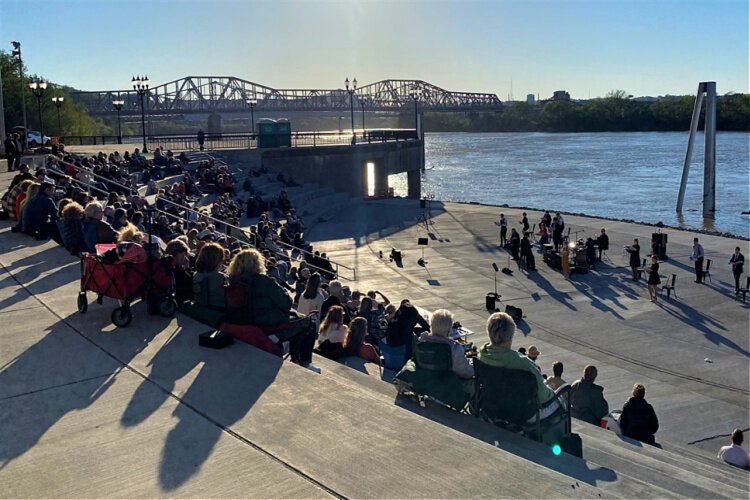
And the opening of Covington Plaza this summer marked a change in thinking from a riverfront once lined with floating restaurants and an entertainment district to one where walkers and runners can simply enjoy the beauty of the river or maybe take in an outdoor concert.
“For a long time, we were either blocking the river or trying to tame it,” says Ken Smith, Covington’s city manager and former neighborhood services director. “Going forward, the city is embracing its riverfront and giving residents more opportunities to access and appreciate its beauty.”
But our streets and parks aren’t just for recreation. They also serve a role for protest, as places to gather in numbers and demand change. “It’s the only space we really have to voice our discontent, to voice our demands,” Mehta says. “I think that is one of the predominant roles of public spaces.”
In the wake of the George Floyd killing at police hands in Minneapolis, protests took place in streets and parks around the country, including Cincinnati and Northern Kentucky. Some were spontaneous and violent, most were organized and peaceful.
In 2011, a protest against corporate power and economic inequality took place in New York City, as protestors camped out in a park near Wall Street for a couple of months. The Occupy movement spread across the country, and in Cincinnati, protestors took over Piatt Park downtown, Cincinnati’s oldest park, for about two weeks.
“Public spaces are essential to democracy,” Greenberg says.
Indeed, they literally belong to the people – all of us.
“Public space is for many publics,” Mehta says.
And in a tiny pocket park on Vine Street, as cars and people roll by all day long, the public is invited to pause for a moment or two and contemplate the messages student artists left years ago: peace, love, and unity.
You can view and listen to The Case for Cities conversation series here.
The Case for Cities: Cities of Choice are Cities of Justice series is a partnership between UC School of Planning and Soapbox Cincinnati, made possible with support from The Carol Ann and Ralph V. Haile, Jr. Foundation.

